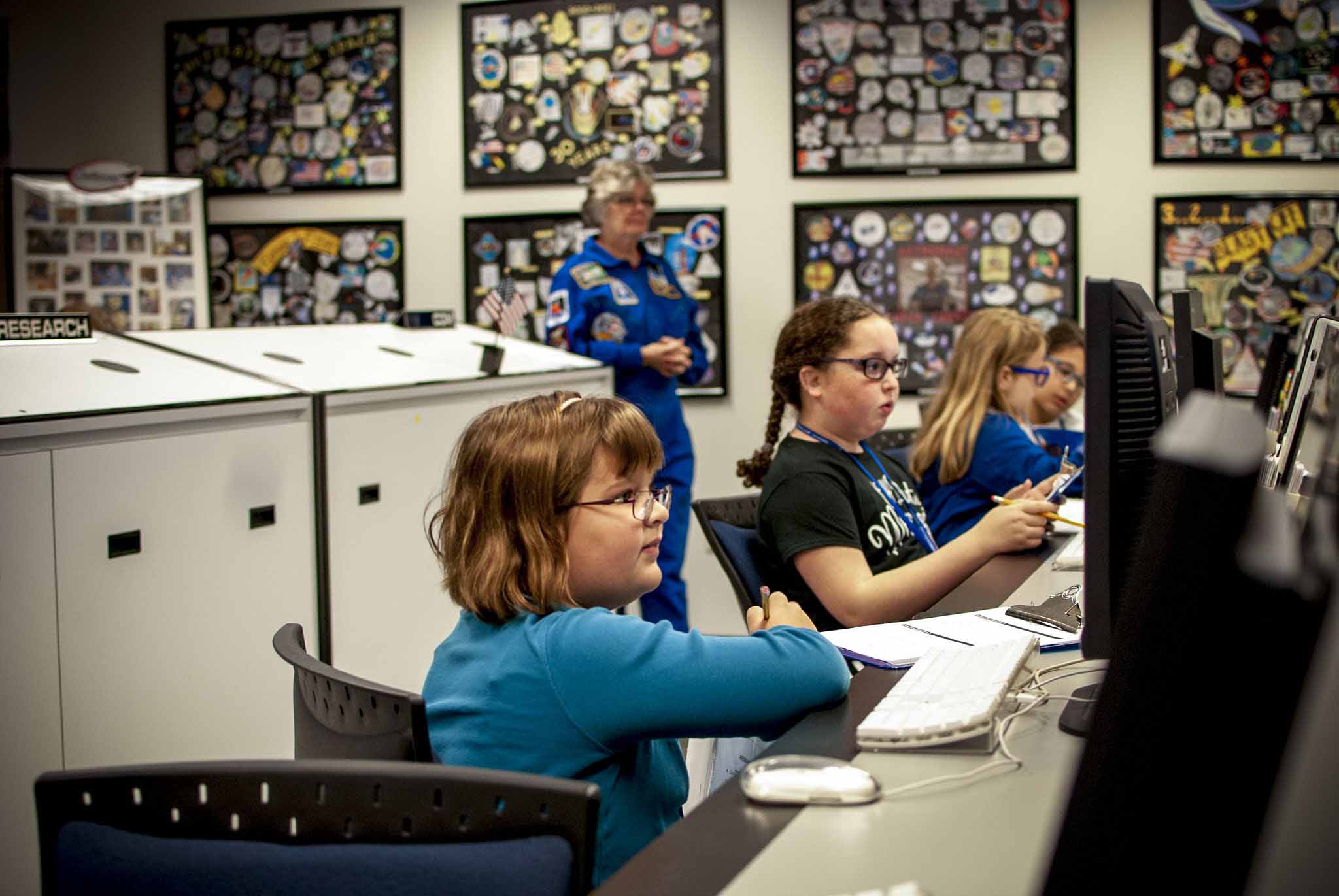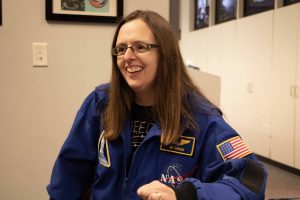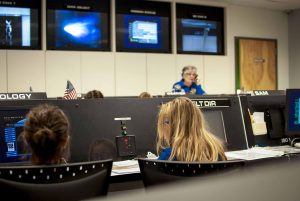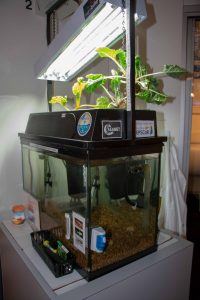
ME EPSCoR’s workforce development partner Challenger Learning Center exposes Maine youth to potential STEM careers
Maddy Jackson, ME EPSCoR Student Writer
Among the high priority goals for Maine EPSCoR is workforce development through the support of hands-on STEM learning. For the past six years, Maine EPSCoR has been a committed partner of the Challenger Learning Center in Bangor to support career pathways in STEM for Maine’s youth.

After the space shuttle Challenger disaster in 1986, the families of the astronauts aboard the shuttle came together to form the Challenger Center for Space Science Education “with the goal of continuing the crew’s education mission — to learn, to explore, and to inspire,” according to the Challenger Center website. With over 40 locations now in the United States, Canada, Asia, and Europe, the Challenger Learning Center hosts a number of educational programs to engage people of all ages in science, technology, engineering, and mathematics. Behind the planning of these programs at the Bangor location is Education Director and Center Coordinator Jennifer Therrien.
Therrien has been with the center for 14 years and plans programs, develops new events, hosts school groups and prepares teachers for visits to the center, trains staff members, and connects with partners like Maine EPSCoR to develop new ideas and foster further collaborations.
“Some things in this program never change, and they’ve really stood the test of time,” Therrien said of her tenure at the center. “We’re putting kids in careers and having them try things out and always have been very hands on … the model works but it’s neat to know that what we’re doing fundamentally makes sense.”
Maine EPSCoR has supported the Challenger Center’s workforce development goals in a variety of ways and Program and Outreach Director, Laurie Bragg, has initiated and co-hosted several events in collaboration with the center. These initiatives include a Women in STEM series (a free program for young girls to meet women already established in STEM career paths), a free camp for low income or at-risk youth where attendees were tasked with creating stop motion PSAs on aquaculture, as well as funding several interns from Husson University over the years to deliver marine science or ocean-related lessons at the center.
“The Maine Challenger Learning Center is valuable partner in developing programs that increase STEM engagement.” Bragg said “They have a statewide reach, strong community support, and a willingness to try new innovative projects.”
Among these programs is the “Dolls in Space” event during which youth are invited to dress their dolls up in full space suits and take part in hands-on science experiments and arts activities, often for the first time in their lives. This free event has been offered to the community through partnership with Maine EPSCoR with the intention of giving girls the opportunity to visualize themselves in potential STEM careers. The Dolls in Space event is particularly popular and has been completely full a number of times.
“It is important for Maine EPSCoR to partner with the Challenger Learning Center to support these types of programs for young girls,” Bragg said. “There is a real need for programs that encourage girls to engage in fun STEM activities while at the same time help them begin to envision themselves as scientists, engineers, or mathematicians.”
Definitively the most common program offering from the center are the lunar or Mars mission simulations during which participants must complete a series of objectives to explore and conduct science in space. To complete the mission, participants are given a particular job on the mission’s team, split into two categories: mission control and space lab.

“Mission control is looking up the research on what the levels should be, their partner finds out what they are [and] has to communicate that, and then they have to process it,” explains Therrien. “So they’re analyzing data, they’re effectively communicating, [and] there is potential for multiple problems so there is problem-solving.”
This hands-on mission is preceded by an official launch with a video presentation of a former U.S. or Russian shuttle take off — something that many youths have not had the opportunity to witness since fewer launches have been televised after the tragic Challenger accident. The introduction to the launch also outlines what each participant in their assigned job is being commissioned to achieve while on their mission.
“NASA doesn’t employ one type of person,” Therrien said. “So we’re mimicking the types of people in many different fields.”
Thse diverse fields range from navigation to hazmat monitoring. Participants may be asked to measure, calculate, and report back to mission control weather, biological discoveries, medical status of the mission’s passengers, and any anomalies or emergencies that arise along the way. Each station requires engaging different skills as they command responsibility for their position and their role in making sure the mission is a success.
“We are empowering them to run this, and it won’t be the same every time because they are going to find different things, [and] they’re going to work at a different pace,” says Therrien. “But we try to intervene as little as possible so that when they fix the oxygen problem, they take credit for it.”
With each of these positions comes different responsibilities and potential problems, and all participants must work as a team to conduct a successful space mission. These complications programmed into the mission simulation inspire participants of all ages to think on the spot from the unique perspective of their contributing job.
According to the center’s website, “currently, an unacceptably high proportion of Maine’s middle school students do not meet state standards for educational attainment in mathematics and science. And while a high percentage of our students graduate from high school, too few go on to college – largely because of low aspirations.” The programs developed, supported, and hosted by the Challenger Learning Center are designed to directly combat this discrepancy in Maine’s STEM career pathways. They aspire to encourage young students to pursue an education in the math and science fields as well as support STEM graduates to pursue further careers in the state of Maine, therefore exemplifying a fierce dedication to the development of a diverse STEM workforce across the state.

“I’ve always had the idea in mind that if you don’t know what an engineer does you’re not going to become one,” Therrien said. “You just need that exposure.”
That exposure is the main focus of workforce development-focused organizations like the Challenger Learning Center.
“We always end by telling the group it isn’t just NASA that needs people with these skills. If [they] liked the job [they] had today or liked a skill that [they] used then we show a list of companies in Maine that are always looking for workers in STEM fields,” Therrien said.
Maine EPSCoR has sponsored a number of developments for the Challenger Learning Center including the installation of an aquaponics tank in the mission simulator space lab. The aquaponics tank is representative of the real-life food and plant cultivation currently taking place during NASA’s space research missions.
“They do plant research [and] fish research in space, and you could have that [aquaponics] system in a future lunar or mars habitat,” said Therrien. “Now all kinds of people get to see that system, and some of them have access to one in their own school so they’ve seen one, but for a lot of people it’s brand new exposure.”
Whether participants become inspired to pursue a pathway that may ultimately land them a career with NASA or not, the opportunities for STEM career cultivation is a core advantage of having these workforce development programs supported by Maine EPSCoR.
To learn more about the Challenger Learning Center visit their website at the Challenger Learning Center of Maine.
